Round 7 – Hawthorn Vs Melbourne
Liam Chambers
Demon fans were relieved after last weeks’ win when the Hawks were grounded by the rampant Dees. Now they have a vaguely familiar feeling. A sense of optimism.
From the initial bounce, the Hawks exerted pressure on Melbourne, with Jack Gunston scoring the first goal within a minute. Up the other end Kysaiah Pickett was displaying some nice dance moves. Unfortunately, his innovations didn’t yield the desired result. The Hawks looked to have the better chances early on but Melbourne managed to keep them in check. Harley Bennell continues to repay the trust of his new side and his confidence is growing with each game.
The Dees are tackling with more intensity and purpose. This was epitomised by Mitch Hannan when he was awarded a free kick on the 50 metre line. His set shots have also been impressive and he notched up the first goal for Melbourne. A minute later Jack Viney, as always fiercely competitive, was also rewarded a free kick for a tackle and converted for the Dees’ second. Christian Petracca has moved up another level this year. His football is inspirational and his visionary kick to Jack Viney allowed the midfielder to get the ball to Bailey Fritsch for number three.
At the start of the second quarter, Hawthorn made a few forays in Demon territory but Melbourne quickly kept finding a way back. An accurate hand ball from Bennell to Hannan gave Melbourne the opening goal of the second term. Max Gawn continued to frustrate the Hawks by marking the ball as it was kicked towards the Dees’ back line. Up the other end Petracca was in the zone. He spotted Sam Weiderman in front of the Hawthorn goal and launched a perfect kick into the forward’s waiting hands. Sam was only too happy to kick the fifth for Melbourne.
When the Dees are on a roll they often take a minute to relax and reflect. Jaeger O’Meara took advantage of the lull to get one back for the Hawks. Great goal though. Melbourne responded brilliantly with a Luke Jackson kick to Harley Bennell, allowing him to run and kick scoring from 30 metres out. The Dees were flowing when Tracca, in a good position to kick goal-ward, instead passed to Kysaiah Pickett who grabbed the ball, turned and snapped for his first and Melbourne’s seventh goal. Hawthorn almost got one back just before the siren when Darren Mitchington’s superb kick was touched on the line. Kudos to Oscar McDonald.
Hawthorn, desperate to avoid a walkover, came out swinging at the start of the second half. Gunston got his second early on before Chad Wingard made it two in a row for the Hawks. With the margin reduced to three goals, the Dees looked a little rattled. Luckily, a few Hawthorn chances went begging and Jake Melksham produced a great kick to Bailey Fritsch who hand balled on to the unmarked Weiderman in front of goal. After that, the wind was taken out of Hawthorn’s sails and subsequent waves of attack were handled much more confidently by Melbourne.
A promising sign for the Dees is their increasing accuracy from set shots. Melksham got his second from a free kick on the 50 metre line thus restoring their half time advantage. Melbourne’s tenth goal was fast and furious. Clayton Oliver took advantage of a free kick to get the ball to Weiderman who hand balled over the top to an unmarked Luke Jackson. First goal for Action Jackson. With their cup overflowing, the Dees got another thirty seconds later. A handball from Tracca to Bennell was beautifully kicked on to Pickett. Pickett’s set shot from 40 metres sailed through the uprights perfectly. Second goal for Kysaiah the Messiah.
Going into the last term with the scoreboard showing 30-72 in Melbourne’s favour was an unusual sight for Demon fans. We knew not to get too excited though. We’ve let a forty two point margin slip before. In a sure sign that Tracca has moved up to another level, he marked on the 50 metre line and made no mistake converting for the Dees’ twelfth. A year ago, he would have passed to another player or kicked the ball wide. Now his confidence has skyrocketed. Even though Chad Wingard and Josh Morris got a couple back for the Hawks, it would only be a consolation as Sam Weiderman hit back to claim his hat trick.
Time for a little exhibition play; starting with Christian Salem then Pickett, Ed Langdon, Oscar McDonald and finally of course Petracca, whose superb squaring ball to Fritsch was walked in for number fourteen. Finally, Jack Gunston had the last word when his goal from fifty five metres out book ended the match.
Though we’ve improved significantly, the Hawks were far from their best. Our next game against Brisbane will be the real test. Melbourne will be the underdogs and that will be to our advantage. However, we can’t allow old habits to creep back in when we’re up against an opposition that has top four written all over them.
The lads have to play their natural game and not over think the situation. If they can be in the moment, then their instincts won’t let them down. There are so many positive signs and they need to harness the energy they’ve created over the last two games. I’m going to suggest a mantra: “Be like Tracca”
Go the Mighty Dees!!!


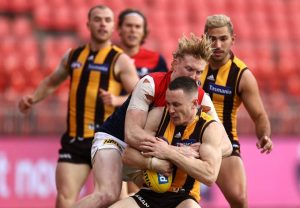
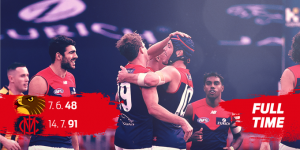
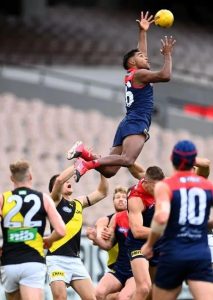
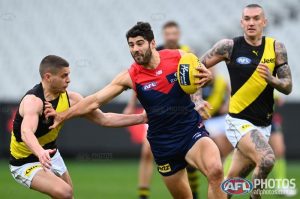


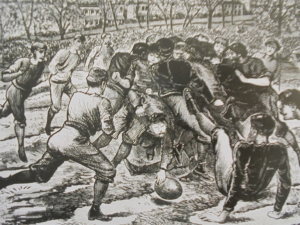
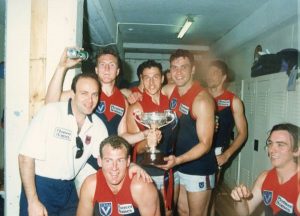
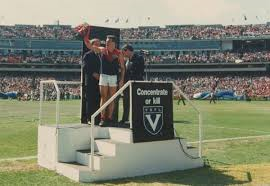

 Follow us on twitter
Follow us on twitter Join our facebook group
Join our facebook group